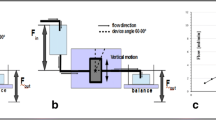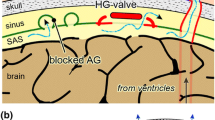Abstract
Overdrainage in upright position is one of the most prevalent issues in treating hydrocephalus with a cerebrospinal fluid (CSF) shunt. Anti-siphon devices (ASDs) are employed to reduce this problem. A novel microelectromechanical system (MEMS)-based valve, termed Chronoflow device, aims to regulate CSF drainage indifferently of the body posture. With this study, the suitability of this MEMS-based valve is evaluated regarding its use for the treatment of hydrocephalus, particularly for the prevention of overdrainage and blockage. In total, four Chronoflow devices were tested. An established in-vitro hardware-in-the-loop (HIL) test bed was used to investigate the valves regarding their pressure-flow characteristics, their behaviors towards CSF dynamics, and their capabilities to prevent CSF overdrainage in upright position. Additionally, a contamination test was conducted to evaluate the susceptibility of the device to blockage due to particles. All valves tested regulated the drainage rate at similar nominal flows and independently of posture. The pressure-flow relation measured, however, was notably higher than numerically calculated. Regarding the CSF dynamics, the first three valves tested led to a decreased steady-state intracranial pressure in supine position and showed stable drainage rate in upright position. During the transitional phase from supine to upright and vice versa, the valves continuously adjusted the outflow resistance, which resulted in a stable transitional phase preventing overdrainage. Yet, the fourth valve showed continuous overdrainage in upright position due to an increased nominal flow. However, after several test iterations the nominal flow decreased and stabilized at a level similar to that of the first three valves tested. The contamination test showed that most particles initially adhere to the pillars and spread throughout the cavity of the valve as the concentration of particles increases, thereby affecting the displacement of the membrane. The devices generally provide a stable flow regulation and prevent overdrainage in upright position. Specifically, their drainage behaviors during the posture changes are very effective. However, they also showed high hysteresis and sensitivity towards particle contamination, which resulted in initial increased and altering nominal flows after many test iterations. This result suggests that the MEMS design presented lacks robustness. Yet, an upstream filter and specific coatings on the fluid pathway may increase significantly its reliability.










Similar content being viewed by others
References
I.G. Bloomfield, I.H. Johnston, L.E. Bilston, Effects of proteins, blood cells and glucose on the viscosity of cerebrospinal fluid. Pediatr. Neurosurg. 28(5), 246–251 (1998)
E. Chappel, Design and characterization of a passive flow control valve dedicated to the hydrocephalus treatment. Cogent. Eng. 3(1), 1247612 (2016)
E. Chappel, D. Dumont-Fillon, S. Mefti, Passive flow regulators for drug delivery and hydrocephalus treatment. Microfluidics, BioMEMS, and Medical Microsystems XII 8976, 89760S, International Society for Optics and Photonics (2014)
E. Chappel, M. Hannebelle, L. Cornaggia, S. Momjian, Hybrid hydrodynamic characteristic for hydrocephalus valve: A numerical investigation using electrical equivalent networks. Cogent. Eng. 4(1), 1415103 (2017)
E. Chappel, H. Musard, D. Dumont-fillon, Experimental characterization and modelling of microfluidic radial diffusers for passive self-regulating valves. Glob. J. Eng. Technol. Adv. 01(01), 10–21 (2019)
A. Chari, M. Czosnyka, H.K. Richards, J.D. Pickard, Z.H. Czosnyka, Hydrocephalus shunt technology: 20 years of experience from the Cambridge shunt evaluation laboratory. J. Neurosurg. 120(3), 697–707 (2014)
S. Chung, J.K. Kim, K.C. Wang, D.-C. Han, J.-K. Chang, Development of MEMS-based cerebrospinal fluid shunt system. Biomed. Microdevices 5(4), 311–321 (2003)
W.S. Cobb, J.M. Burns, K.W. Kercher, B.D. Matthews, H. James Norton, B. Todd Heniford, Normal intraabdominal pressure in healthy adults. J. Surg. Res. 129(2), 231–235 (2005)
L. Cornaggia, L. Conti, M. Hannebelle, S. Gamper, D. Dumont-Fillon, H. Van Lintel, P. Renaud, and Eric Chappel, Passive flow control valve for protein delivery. Cogent. Eng. 4(1), 1413923 (2017)
R. Di Terlizzi, S. Platt, The function, composition and analysis of cerebrospinal fluid in companion animals: Part I - function and composition. Vet. J. 172(3), 422–431 (2006)
L. Ferrara, A. Fleischman, D. Togawa, T.W. Bauer, E.C. Benzel, S. Roy, An in vivo biocompatibility assessment of MEMS materials for spinal fusion monitoring. Biomed. Microdevices 5, 297–302 (2003)
M. Gehlen, V. Kurtcuoglu, M. Schmid Daners, Patient specific hardware-in-the-loop testing of cerebrospinal fluid shunt systems. IEEE Trans. Biomed. Eng. 63(2), 348–358 (2016)
M. Gehlen, A. Eklund, V. Kurtcuoglu, J. Malm, M. Schmid Daners, Comparison of anti-siphon devices—How do they affect CSF dynamics in supine and upright posture? Acta Neurochir. 159(8), 1389–1397 (2017)
S.B. Johansson, A. Eklund, J. Malm, G. Stemme, N. Roxhed, A MEMS-based passive hydrocephalus shunt for body position controlled intracranial pressure regulation. Biomed. Microdevices 16(4), 529–536 (2014)
Y. Kajimoto, T. Ohta, H. Miyake, M. Matsukawa, D. Ogawa, K. Nagao, T. Kuroiwa, Posture-related changes in the pressure environment of the ventriculoperitoneal shunt system. J. Neurosurg. 93(4), 614–617 (2000)
S.A. Lee, H. Lee, J.R. Pinney, E. Khialeeva, M. Bergsneider, J.W. Judy, Development of microfabricated magnetic actuators for removing cellular occlusion. J. Micromech. Microeng. 21(5), 54006 (2011)
B.R. Lutz, P. Venkataraman, S.R. Browd, New and improved ways to treat hydrocephalus: Pursuit of a smart shunt. Surg. Neurol. Int. 4(Suppl 1), S38–S50 (2013)
H. Miyake, T. Ohta, Y. Kajimoto, K. Nagao, New concept for the pressure setting of a programmable pressure valve and measurement of in vivo shunt flow performed using microflow meter. J. Neurosurg. 92(1), 181–187 (2000)
J. Oh, G.M. Kim, F. Kralick, H. Noh, Design and fabrication of a PDMS/Parylene microvalve for the treatment of hydrocephalus. Microelectromech. Syst. J. 20(4), 811–818 (2011)
S. Qvarlander, B. Lundkvist, L.-O.D. Koskinen, J. Malm, A. Eklund, Pulsatility in CSF dynamics: Pathophysiology of idiopathic normal pressure hydrocephalus. J. Neurol. Neurosurg. Psychiatry 84(7), 735–741 (2013a)
S. Qvarlander, N. Sundstrom, J. Malm, A. Eklund, Postural effects on intracranial pressure: Modeling and clinical evaluation. J. Appl. Physiol. 115(10), 1474–1480 (2013b)
R. Spector, S. Robert Snodgrass, C.E. Johanson, A balanced view of the cerebrospinal fluid composition and functions: Focus on adult humans. Exp. Neurol. 273, 57–68 (2015)
C. Wetzel, L. Goertz, P. Noé, N. von Spreckelsen, M. Penner, C. Kabbasch, R. Goldbrunner, B. Krischek, Flow-regulated versus differential pressure valves for idiopathic normal pressure hydrocephalus: Comparison of overdrainage rates and neurological outcome. Acta Neurochir. 162(1), 15-21 (2020)
H.J. Yoon, J. Myoung Jung, J. Suk Jeong, S. Yang, Micro devices for a cerebrospinal fluid (CSF) shunt system. Sensors Actuators A Phys. 110(1–3), 68–76 (2004)
Acknowledgements
-
The project was financed by Innosuisse: 32268.1 INNO-LS “Flow control valve for medical application” and by the Swiss National Science Foundation through the grant 315230_184913. The sponsors had no role in the design or conduct of this research.
-
The Authors thank Philippe Renaud for the fruitful discussions regarding the manufacturing process flow (LMIS4, Swiss Federal Institute of Technology EPFL, Lausanne 1015, Switzerland), as well as Damien Lamaison (Debiotech SA) and the staff of the Center of MicroNanoTechnology at EPFL for their support.
Author information
Authors and Affiliations
Corresponding author
Ethics declarations
Ethical approval
This article does not contain any studies with human participants or animals performed by any of the authors.
Conflict of interest
The authors declare that they have no personal or institutional conflict of interest.
Additional information
Publisher’s note
Springer Nature remains neutral with regard to jurisdictional claims in published maps and institutional affiliations.
Rights and permissions
About this article
Cite this article
Tachatos, N., Chappel, E., Dumont-Fillon, D. et al. Posture related in-vitro characterization of a flow regulated MEMS CSF valve. Biomed Microdevices 22, 21 (2020). https://doi.org/10.1007/s10544-020-0471-0
Published:
DOI: https://doi.org/10.1007/s10544-020-0471-0




